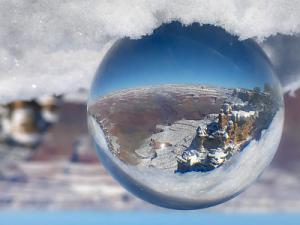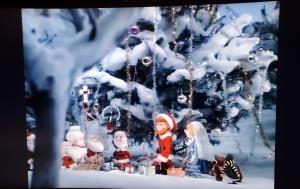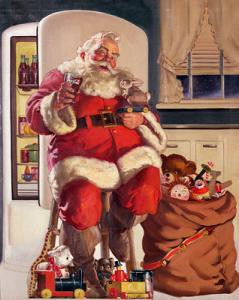
Magic is everywhere. In December, the Soul Matters theme was mystery. If you ask me, that is only the beginning.
Starting in December, there is the mystery of Santa Claus and his famous reindeer. Some people won’t allow their children to believe in him because they claim he is Christian. Catholics do refer to him as the monk, St. Nicholas, the patron saint of children. Around 280 C.E, St. Nicholas was born in the village of Patara, near Myra in what is now known as Turkey. Dec. 6, the date of his death is still celebrated with a feast.
Sinter Klaas or Sint Nikolaas in Dutch, which we get the name Santa Claus.
Then there is Kris Kringle, a name given to St. Nicholas by teacher/monk Martin Luther during the Protestant Reformation in the 1500s. Luther didn’t believe in saints and claimed it was against scripture. The idea was introduced that “Santa” brought presents to all the good kids. In Germany, he is the “Christkind” or Christ-child.” And in the 1840s, it became Kris Kringle.
However the legend really doesn’t matter. There’s no harm in a child stretching their imagination by believing in Santa Claus, regardless of their family’s religious traditions.

I just watched all my childhood Christmas classics with my niece. Seeing the wonder in her eyes when Santa Claus was on the screen was the best part, in my opinion. A lot of those old classics were very Pagan. In the movie “Santa Claus is Comin’ to Town,” he marries Jessica in a grove of pine trees. “No church ever looked nicer,” is a quote from the movie. This particular part of the story is very Pagan, since we often say nature is our ‘church.’
The creators, Arthur Rankin Jr. and Jules Bass of “Santa Claus is Comin’ to Town” were in fact Jewish. So, to say that it’s too Christian wasn’t so for them. After All, didn’t Christians take our holidays and twist them to make their “history” fit to their needs?
Just think about it, Jesus was not born in the dead of the winter. In Bethlehem it can get as cold as 33° Fahrenheit in winter. December and January is the rainy season and are usually the coldest months of the year. Shepherds would move the sheep into town with shelters by October.
According to the text in the Bible, Jesus was most likely born in September. This date suggestion in the Bible follows the story of when Mary was told she was carrying him. It starts with the conception of John the Baptist in June (Sivan). Six months later in December (Kislev) Gabriel announced Jesus’ conception. Nine months later would be Jesus’ birth in September (Tishri).
Under the direction of Emperor Constantine in 354 CE, suggested by Hippolytus, set Jesus’s birth date as Dec. 25. Hippolytus is one of the fathers of the Holy Roman Catholic Church. This date was chosen because of the Pagan festivals of Saturnalia, Sigillaria, and Brumalia. Saternalia all of which predates Jesus. If you have to be at first Mass in the morning, you cannot have been out all night revelling for a Pagan god.
Reindeer flying over rooftops, originated in an illustration in a poem “Old Santeclaus with Much Delight.” in 1821, They were named, however, in the famous poem “A Visit from St. Nicholas,” or now known as “Twas the Night Before Christmas.” The poem, published anonymously, in the Troy, New York Sentinel on Dec. 23, 1823, by Clement Clarke Moore.
There is a claim though that flying reindeer might have come from, surprise, the Norse god Thor. Thor, attributed as the god of thunder, flew a chariot in the sky by two goats. Reindeer adapt to survive in colder environments and most likely the reason they are the animal.

Santa’s famous red suit and white beard, which we all recognize automatically, came from the Coca-Cola soda company, in 1931. Illustrator Haddon Sundblom painted the image for their advertisements, No Pagan origins to this part of the myth.
Recently, the Rev. Scott Sammler-Michael, senior co-minister at the Unitarian Universalist Congregation at Montclair, NJ, spoke about Christmas traditions. In his sermon, he said a lot of what Christians do now have Pagan origins. Holiday symbols such as mistletoe, the Yule log, caroling (wassailing), holly, and even the evergreen tree to name a few. Even the ornaments hung from the tree. Yes, that’s right, they come from the Saturnalia festival.
So, if they could co-op our holidays, there is no reason that we cannot use some aspects of theirs. Likewise, a Pagan, Jewish or a child with no religious background can believe in Santa- as the idea of love and giving. We Pagans constantly emphasize using our imaginations; let these kids use theirs. Let them believe for as long as they can. It is OK, this will help them later in life.
That is one thing my parents never took from me, oddly. However, it didn’t help that my dad would dress up as Santa Claus every Christmas Eve at my cousin’s house. I did try to believe as much as I could, or at least played along. However, my cousins having their gifts out under the tree and my dad in the red suit did not help. I’d actually like to see him dress like that now for my niece. However, he seems more and more to assume the role of the Burgermeister Meisterburger and less like Santa.
So, maybe next time you hear someone say something like “they still believe…” or “Santa is too Christian…” Debunk these myths.
See also: Celebrating Yule While Living In A Christian Home and An Imagination Is Not Just For Kids – Go Play & Find Yours

















